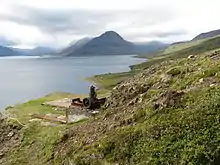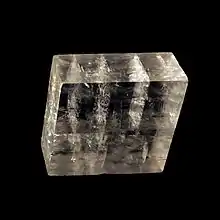Helgustadir mine
Helgustadir mine (Icelandic: Helgustaðanáma) is a mine in the east of Iceland where Iceland spar (a form of transparent calcite) was mined from the mid-17th century to the 20th century.[1] It is the source of the largest and clearest known Iceland spar specimen and the source of most museum specimens of Iceland spar.[2]

It was declared a nature reserve in 1975.[2]

About
Location

The mine is located near Eskifjörður, east of Iceland.[3] Helgustadir mine consists of two mines, known as the upper and lower mine.[3]
Uses
Crystals from this area are known for exceptional clarity,[3] leading to the mineral being named "Iceland spar".[3]
Iceland spar from Helgustadir mine was used in optical devices used in physics, chemistry, and geology,[3] most importantly Nicol prisms.

Theft of crystals
Being a nature reserve, tampering with the rock formations and removing crystals is forbidden.[2][3] Despite that, visitors often take samples with them, causing a disruption of the area.[3] The problem has gotten worse as tourism has increased,[3] with some visitors filling their backpacks with samples.[4][5]
References
- Russell 2008.
- "Helgustaðanáma". Umhverfisstofnun (in Icelandic). Retrieved 2020-08-20.
- "Helgustaðanáma – Stjórnunar- og verndararáætlun 2017–2026" (PDF). Environment Agency of Iceland. 2017.
- runarsr (2017-03-19). "Kristallar hverfa enn úr Helgustaðanámu". RÚV. Retrieved 2019-05-08.
- runarsr (2017-06-13). "Landvörður reynir að stöðva silfurbergsþjófnað". RÚV. Retrieved 2019-05-08.
Further reading
- Russell, Daniel (2008). "Helgustadir Iceland Spar Mine". Mindat.org.CS1 maint: ref=harv (link)